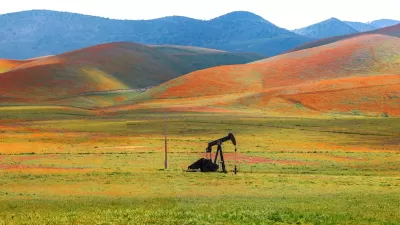Assembly Bill 1866 aims to address the health hazards caused by idle oil wells in low-income communities by enforcing stricter regulations on oil companies to accelerate well cleanup, despite significant opposition from the oil industry.

In January, a dramatic incident in Wilmington, Los Angeles, where oily water erupted from an oil well, underscored the ongoing health hazards faced by residents due to neighborhood oil drilling. Ashley Hernandez, an advocate for Communities for a Better Environment, reflects on growing up with persistent health issues such as asthma and cancer, attributed to toxic emissions from nearby wells. This predominantly low-income, Latino community is heavily impacted by over 2,300 oil wells, many of which are idle and leaking harmful pollutants.
As reported by Liza Gross, California Assembly Bill 1866 aims to address this issue by accelerating the cleanup of idle wells, especially those near homes and schools. The bill intends to move away from the previous "pay to idle" scheme and enforce stricter regulations on oil companies, requiring them to plug more wells annually. This legislative effort is crucial for protecting public health, as studies have shown that idle wells emit significant amounts of methane and other toxic gases.
Despite these efforts, the oil industry has been vigorously opposing such regulations. Industry representatives argue that many idle wells could be revived for production or repurposed for renewable energy storage, claiming that the new laws would impose prohibitive costs and potentially disrupt funding for well plugging. However, environmental health experts and lawmakers like Assemblymember Gregg Hart insist that the majority of these wells are outdated and pose severe risks, necessitating urgent remediation.
Community activists like Hernandez and other local organizations have been instrumental in pushing for these regulatory changes. Their efforts have led to significant local and statewide measures, such as the 3,200-foot buffer zone law to separate drilling operations from residential areas. However, the oil industry continues to challenge these regulations through lawsuits and referendums, demonstrating the ongoing battle between public health advocates and oil companies.
As the fight continues, there is a growing recognition of the environmental racism at play, with low-income communities and communities of color bearing the brunt of the pollution and health hazards from oil drilling. Activists remain determined to shut down harmful drilling sites and ensure that future generations do not suffer the same health issues. The struggle in Wilmington reflects a broader national issue, highlighting the urgent need for comprehensive solutions to protect vulnerable communities from the dangers of oil extraction.
FULL STORY: Battle to Prioritize Public Health over Oil Company Profits Heats Up

Maui's Vacation Rental Debate Turns Ugly
Verbal attacks, misinformation campaigns and fistfights plague a high-stakes debate to convert thousands of vacation rentals into long-term housing.

Planetizen Federal Action Tracker
A weekly monitor of how Trump’s orders and actions are impacting planners and planning in America.

Chicago’s Ghost Rails
Just beneath the surface of the modern city lie the remnants of its expansive early 20th-century streetcar system.

Bend, Oregon Zoning Reforms Prioritize Small-Scale Housing
The city altered its zoning code to allow multi-family housing and eliminated parking mandates citywide.

Amtrak Cutting Jobs, Funding to High-Speed Rail
The agency plans to cut 10 percent of its workforce and has confirmed it will not fund new high-speed rail projects.

LA Denies Basic Services to Unhoused Residents
The city has repeatedly failed to respond to requests for trash pickup at encampment sites, and eliminated a program that provided mobile showers and toilets.
Urban Design for Planners 1: Software Tools
This six-course series explores essential urban design concepts using open source software and equips planners with the tools they need to participate fully in the urban design process.
Planning for Universal Design
Learn the tools for implementing Universal Design in planning regulations.
planning NEXT
Appalachian Highlands Housing Partners
Mpact (founded as Rail~Volution)
City of Camden Redevelopment Agency
City of Astoria
City of Portland
City of Laramie





























